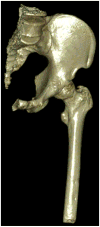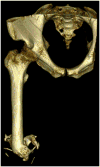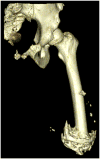Developing a quantitative measurement system for assessing heterotopic ossification and monitoring the bioelectric metrics from electrically induced osseointegration in the residual limb of service members
- PMID: 20458630
- PMCID: PMC3166247
- DOI: 10.1007/s10439-010-0050-2
Developing a quantitative measurement system for assessing heterotopic ossification and monitoring the bioelectric metrics from electrically induced osseointegration in the residual limb of service members
Abstract
Poor prosthetic fit is often the result of heterotopic ossification (HO), a frequent problem following blast injuries for returning service members. Osseointegration technology offers an advantage for individuals with significant HO and poor socket tolerance by using direct skeletal attachment of a prosthesis to the distal residual limb, but remains limited due to prolonged post-operative rehabilitation regimens. Therefore, electrical stimulation has been proposed as a catalyst for expediting skeletal attachment and the bioelectric effects of HO were evaluated using finite element analysis in 11 servicemen with transfemoral amputations. Retrospective computed tomography (CT) scans provided accurate reconstructions, and volume conductor models demonstrated the variability in residual limb anatomy and necessity for patient-specific modeling to characterize electrical field variance if patients were to undergo a theoretical osseointegration of a prosthesis. In this investigation, the volume of HO was statistically significant when selecting the optimal potential difference for enhanced skeletal fixation, since higher HO volumes required increased voltages at the periprosthetic bone (p = 0.024, r = 0.670). Results from Spearman's rho correlations also indicated that the age of the subject and volume of HO were statistically significant and inversely proportional, in which younger service members had a higher frequency of HO (p = 0.041, r = -0.622). This study demonstrates that the volume of HO and age may affect the voltage threshold necessary to improve current osseointegration procedures.
Figures









Similar articles
-
Establishing multiscale models for simulating whole limb estimates of electric fields for osseointegrated implants.IEEE Trans Biomed Eng. 2011 Oct;58(10):2991-4. doi: 10.1109/TBME.2011.2160722. Epub 2011 Jun 27. IEEE Trans Biomed Eng. 2011. PMID: 21712151 Free PMC article.
-
Comparison of development of heterotopic ossification in injured US and UK Armed Services personnel with combat-related amputations: preliminary findings and hypotheses regarding causality.J Trauma. 2010 Jul;69 Suppl 1:S116-22. doi: 10.1097/TA.0b013e3181e44cc7. J Trauma. 2010. PMID: 20622605
-
Press-Fit Bone-Anchored Prosthesis for Patients with Short Transfemoral Amputation.JBJS Essent Surg Tech. 2025 Feb 21;15(1):e23.00007. doi: 10.2106/JBJS.ST.23.00007. eCollection 2025 Jan-Mar. JBJS Essent Surg Tech. 2025. PMID: 39989600 Free PMC article.
-
Surgical technique of a transcutaneous osseointegration prosthesis system (TOPS) for transtibial amputees.Oper Orthop Traumatol. 2025 Apr;37(2):89-100. doi: 10.1007/s00064-025-00888-8. Epub 2025 Feb 19. Oper Orthop Traumatol. 2025. PMID: 39969578 Free PMC article. Review.
-
Surgical technique of minor revision of a transcutaneous osseointegration prosthetic system (TOPS) with implant retention.Oper Orthop Traumatol. 2025 Apr;37(2):133-141. doi: 10.1007/s00064-024-00882-6. Epub 2025 Jan 8. Oper Orthop Traumatol. 2025. PMID: 39774901 Review. English.
Cited by
-
Developing a combat-relevant translatable large animal model of heterotopic ossification.Bone Rep. 2021 Sep 10;15:101127. doi: 10.1016/j.bonr.2021.101127. eCollection 2021 Dec. Bone Rep. 2021. PMID: 34584904 Free PMC article.
-
Changes in the extracellular microenvironment and osteogenic responses of mesenchymal stem/stromal cells induced by in vitro direct electrical stimulation.J Tissue Eng. 2021 Feb 16;12:2041731420974147. doi: 10.1177/2041731420974147. eCollection 2021 Jan-Dec. J Tissue Eng. 2021. PMID: 33643602 Free PMC article.
-
Determining Which Combinatorial Combat-Relevant Factors Contribute to Heterotopic Ossification Formation in an Ovine Model.Bioengineering (Basel). 2024 Apr 3;11(4):350. doi: 10.3390/bioengineering11040350. Bioengineering (Basel). 2024. PMID: 38671772 Free PMC article.
-
Percutaneous osseointegrated prostheses for amputees: Limb compensation in a 12-month ovine model.J Biomech. 2011 Oct 13;44(15):2601-6. doi: 10.1016/j.jbiomech.2011.08.020. Epub 2011 Sep 13. J Biomech. 2011. PMID: 21920525 Free PMC article.
-
System Setup to Deliver Air Impact Forces to a Sheep Limb: Preparation for Model Development of Blast-Related Heterotopic Ossification.JMIR Res Protoc. 2019 Feb 22;8(2):e12107. doi: 10.2196/12107. JMIR Res Protoc. 2019. PMID: 30794203 Free PMC article.
References
-
- Ahrengart L. Periarticular heterotopic ossification after total hip arthroplasty. Risk factors and consequences. Clin Orthop Relat Res. 1991;263:49–58. - PubMed
-
- Akai M, Hayashi K. Effect of electrical stimulation on musculoskeletal systems; a meta-analysis of controlled clinical trials. Bioelectromagnetics. 2002;23:132–143. - PubMed
-
- Albrektsson T, Albrektsson B. Osseointegration of bone implants. A review of an alternative mode of fixation. Acta Orthop Scand. 1987;58:567–577. - PubMed
-
- Andersen R, Davis S, Scoville C. Rehabilitation of military amputees: from injury to independence. Orthopedics. 2008;31:1000–1002. - PubMed
Publication types
MeSH terms
Grants and funding
LinkOut - more resources
Full Text Sources
Medical
Research Materials

